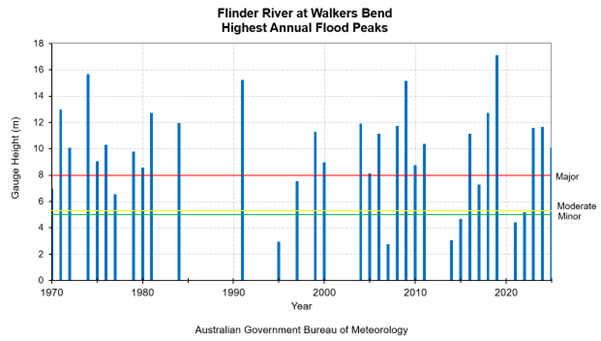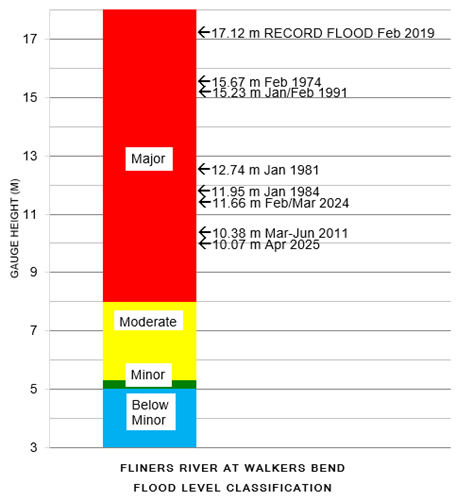This brochure describes the flood risk and previous flooding in the Flinders
River catchment, last updated in August 2025.
Flood Risk
The Flinders River catchment is located in northwest Queensland and drains an area of approximately 109,000 square kilometres. The river rises in the Great Dividing Range, 110 kilometres northeast of Hughenden and flows initially in a westerly direction towards Julia Creek, before flowing north to the vast savannah country downstream of Canobie. It passes through its delta and finally into the Gulf of Carpentaria, 25 kilometres west of Karumba.
The Cloncurry and Corella Rivers, its major tributaries, enter the river from the southwest above Canobie. There are several towns in the catchment including Hughenden, Richmond, Julia Creek and Cloncurry.
Floods normally develop in the headwaters of the Flinders, Cloncurry and Corella Rivers. General heavy rainfall events can develop from cyclonic influences in the Gulf of Carpentaria which cause widespread flooding, particularly in the lower reaches below Canobie. Flood peak height and travel times downstream of Cloncurry may also be impacted from rainfall influences in the Gulf or breakout flow from or to neighboring floodplains.
Previous Flooding
Previous flood information for the Flinders Rivers is well documented. The towns of Hughenden, Richmond and Cloncurry have extensive peak height records dating back around 50 years.
In February 2019, a slow-moving monsoon trough with an embedded tropical low, resulted in prolonged record rainfall event in parts of northern and northwestern Queensland. Areas around Hughenden, Richmond, Julia Creek and Cloncurry recorded 7 to10-day rainfall totals of 400 to 800 mm. Many locations received well over their average annual rainfall in less than a week and numerous long-standing daily and weekly rainfall and flood records were broken. Widespread major flooding across the region also resulted in massive livestock losses, and prolonged isolation of communities and the inundation of many properties throughout the catchment.
More recently significant flooding with moderate to major flood level peaks were observed on the lower reaches of the Flinders River downstream of Cloncurry in 2023, 2024, and 2025.
The table below summarises the flood history of the Norman River catchment - it contains the flood gauge heights of the more significant recent floods.
The following table presents historical flood levels recorded at key locations within the Flinders River catchment, including Hughenden Post Office, Richmond, Cloncurry, Julia Creek, and Walkers Bend. These records reflect the extent and variability of flooding across the region over time.
| Flood Event | Hughenden Post Office (m) | Richmond (m) | Cloncurry (m) | Julia Creek (m) | Walkers Bend (m) |
| Feb 1944 | 3.66 | 9.75 | - | - | - |
| Jan 1946 | 5.03 | 10.06 | - | - | - |
| Jan 1951 | 2.90 | 10.47 | - | - | - |
| Mar 1955 | 2.90 | 11.43 | - | - | - |
| Jan/Feb 1974 | 2.05 | 8.47 | 6.99 | 5.43 | 15.67 |
| Jan 1981 | 2.60 | 7.80 | 5.70 | - | 12.74 |
| Jan/Feb 1984 | 2.10 | 8.40 | 6.30 | 3.16 | 11.95 |
| Jan/Feb 1991 | 3.90 | 7.50 | 8.12 | 4.82 | 15.23 |
| Mar 1997 | - | - | 10.01 | 3.52 | - |
| Jan/Feb 2009 | 2.90 | 8.21 | 8.03 | 3.98 | 15.06 |
| Mar–Jun 2011 | 4.30 | 5.10 | 9.20 | 3.34 | 10.38 |
| Feb 2019 | 3.60 | 9.81 | 6.75 | 5.03 | 17.12 |
| Feb/Mar 2023 | *1.39 | - | 3.62 | 3.72 | 11.61 |
| Feb/Mar 2024 | *1.58 | 6.78 | 4.35 | - | 11.66 |
| Feb–Apr 2025 | - | 8.22 | 4.06 | 3.18 | 10.07 |
All heights are in metres on flood gauges.
*Note: The gauging station at Hughenden Post Office closed in 2019 and the current Hughenden gauge was only recently installed and has data since 2023. As these sites are not collocated, direct comparisons between new observations and historical flood levels cannot be made. However, data from the old Post Office gauge has been included in the table above for reference.




Further Information:
- Latest rainfall and river heights
- For information on the flood warning service for the Flinders River: Queensland Service Level Specification
- Catchment map: Queensland Flinders, Morning Basins map
- National Arrangements for Flood Forecasting and Warning









